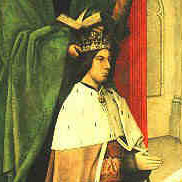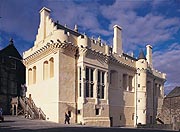|

|
James III from an altarpiece commissioned by the king c.1480.
|
|
|
|
|
 |
 |  |
 Bell-the-cat. Archibald Douglas, Earl of Angus, was so called. James III. made favourites of architects and masons. One mason, named Cochrane, he created Earl of Mar. The Scotch nobles held a council in the church of Lauder for the purpose of putting down these upstarts, when Lord Gray asked, "Who will bell the cat?" "That will I," said Douglas, and he fearlessly put to death, in the king’s presence, the obnoxious minions. 4
Bell-the-cat. Archibald Douglas, Earl of Angus, was so called. James III. made favourites of architects and masons. One mason, named Cochrane, he created Earl of Mar. The Scotch nobles held a council in the church of Lauder for the purpose of putting down these upstarts, when Lord Gray asked, "Who will bell the cat?" "That will I," said Douglas, and he fearlessly put to death, in the king’s presence, the obnoxious minions. 4
|
 |
 |
 |
|
Robert Cochrane was an architect, whose skill in his craft, and whose courage in single combat, attracted the attention of James III (1451-1488). Cochrane soon became the King’s favourite: he was made prime minister and, in 1479, given the holdings and title of earl of Mar.1 Although the family was well established by the 12th century, and held a lordship from the 14th, some histories refer to Cochrane as a common mason or a minor member of James' household.2
James III was "ane man that loved solitude, and desired nevir to hear of warre, bot delighted more in musick and policie and building nor he did in the government of the realme." His preference for the company of scholars, architects and artists, and his increasing attachment to favourites of humble birth, infuriated his nobles and diminished his popularity.

|
Stirling Castle, the great hall.
|
|
|
"In 1482 James III. with his court and army rested here on the way to raise the siege of Berwick. While the nobles were in the church considering grievances, Robert Cochrane, recently created earl of Mar, one of the king’s favourites, whose 'removal' was at the very moment under discussion, demanded admittance. Archibald Douglas, [5th earl of Angus], opened the door and seized Mar, who was forthwith dragged to Lauder Bridge and there, along with six other obnoxious favourites, hanged in sight of his royal master." 3
Robert Cochrane is remembered today for designing and building the great hall of Stirling castle. Begun in the early tenth century but dismantled in the twelfth, the current foundations of the castle date from the fifteenth century. The great hall was one of the first and certainly the finest of the fifteenth-century Renaissance buildings erected in the British Isles.
There is nothing to associate Robert Cochrane with Freemasonry other than his work as an architect and mason, nor is there any reason to view his hanging as an attack on stonemasons or Freemasonry.
1. Life of Sir Robert Cochrane, London: A. Dodd, 1734. 55 pp. 8vo1. [based on early chronicles by Lindsay and Buchanan].
2. <www.royal.gov.uk>.
3. Excerpt from: <13.1911encyclopedia.org/L/LA/LAUDER.htm>.
4. The Dictionary of Phrase & Fable, E. Cobham Brewer (1810-1897). Newark, 1898. p. 121.
|
|